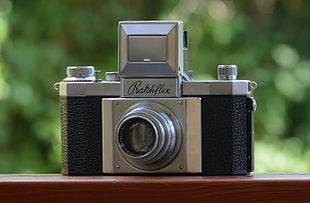Praktiflex
The Praktiflex is a historically important 35mm reflex camera made by the camera workshops Charles A. Noble ("KW") near Dresden .
Development and launch
The camera was developed from 1937 under Benno Thorsch and the designer Alois Hoheisel. Praktiflex cameras were produced by the camera workshops Guthe & Thorsch GmbH (from 1938 camera workshops Charles A. Noble, from 1948 VEB Kamerawerke Niedersedlitz) between 1938 and 1949. As early as 1938 - two years after the Kine Exakta of Ihagee - presented the company's first single-lens SLR cameras of the model Praktiflex ago. The new owners of the Charles A. Noble family brought the Praktiflex onto the market in 1939. The main designers were probably Benno Thorsch and Charles A. Noble himself. Noble registered the Praktiflex trademark on April 14, 1939. The camera was presented at the Leipzig spring fair in 1939.
Historical significance and special features
The Praktiflex is of historical importance because it is the third series-produced single-lens reflex camera worldwide after the Kine Exakta from Ihagee (1936) and the camera Sport (Спорт) from the Russian company GOMZ (1936). In addition, the camera is the first to have a swing-back mirror and a screw thread for interchangeable lenses . The return mirror is caused by pressing the shutter button folded and returns to its original position when the trigger is released. Until 1948/49, the Praktiflex cameras used the rare M40 screw thread to which only Praktiflex lenses fit (see below for a list of available lenses).
Model variants
First generation of cameras
During the production period, several model variants of the first generation of cameras can be distinguished ( Praktiflex writing either in cursive or in block letters ; small or large rewind button; in addition to the standard black synthetic leather cover , it was also available in red, brown and blue).
Second generation of cameras
In 1947 an improved Praktiflex with a new internal mechanism and shutter release on the front of the camera was presented. The actuated trigger folds up the spring-loaded mirror, whereby it only returns to its starting position when the camera is opened again. The external camera properties are very similar to the first generation of cameras. The camera is referred to by collectors as the Praktiflex II (also Praktiflex, 2nd generation ). It also initially has the M40 screw thread; the later very successful M42 lens thread, first used in the Contax S , was not adopted until the production of the first Praktica began (1948/49) . The production of the camera was stopped in 1951.
Matching lenses
Only a small selection of normal lenses with M40 screw thread was available for the Praktiflex:
- Schneider-Kreuznach Xenar 1: 3.5 f = 5 cm
- Schneider-Kreuznach Xenon 1: 2 f = 5 cm
- Ludwig Anastigmat Victar 1: 2.9 f = 5 cm
- Carl Zeiss Jena Tessar 1: 3.5 f = 5 cm
- Carl Zeiss Jena Biotar 1: 2 f = 5 cm
Praktiflex as a Praktica forerunner
Praktiflex cameras are considered to be the forerunners of the Praktica cameras produced by VEB Pentacon Dresden with M42 lens thread from 1948 onwards .
literature
- Günther Kadlubek, Rudolf Hillebrand: Kadlubeks camera catalog , 5th edition, Verlag Rudolf Hillebrand, Neuss 2004, ISBN 3-89506-995-7 .
- James M. McKeown, Joan C. McKeown: McKeown's Price Guide To Antique & Classic Cameras , 12th edition, ed. Centennial Photo Service, Grantsburg 2004, ISBN 0-931838-40-1 .
Web links
Footnotes
- ↑ Praktiflex SLR , page on Praktica-collector.de, accessed on August 18, 2015.
- ↑ a b Praktiflex , page on dresdner-kameras.de, accessed on August 15, 2015.
- ↑ KW , page on camerapedia.org, accessed on August 15, 2015.
- ^ GOMZ, Sport , page on collectiblend.com, accessed August 15, 2015.
- ↑ Praktiflex , page on camerapedia.wikia.com, accessed on August 15, 2015.
- ↑ Praktiflex - 1st Generation , page on Praktica-collector.de, accessed on August 18, 2015.
- ↑ Praktiflex 2nd Generation , page on Praktica-collector.de, accessed on August 18, 2015.
- ^ Günther Kadlubek, Rudolf Hillebrand: Kadlubeks camera catalog , 5th edition, Verlag Rudolf Hillebrand, Neuss 2004, ISBN 3-89506-995-7 .
- ↑ a b c Engraving on the lens: "F = 5 cm"
- ^ Ludwig , page on camera-wiki.org, accessed on August 15, 2015.

